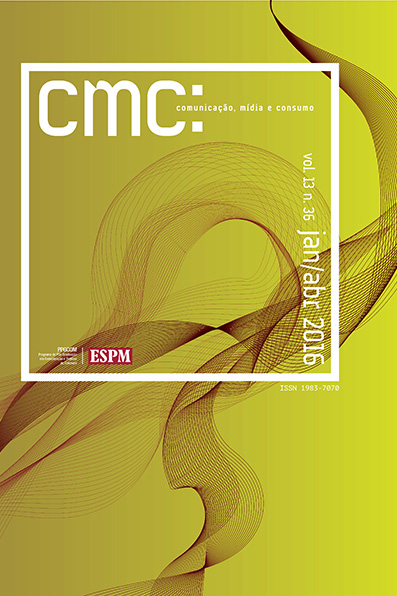The success of the vigilante-hero archetype: science, technology and ethics in The Dark Knight trilogy
DOI:
https://doi.org/10.18568/cmc.v13i36.1073Keywords:
Imaginary, Cultural identification, Archetype, Hero, BatmanAbstract
The narratives of Batman reveal an imaginary in which the hero’s archetype is filled with the “vigilante” image, which can be the main element in the cultural identification between the audience and the protagonist. In the film trilogy The Dark Knight, the main resources of this vigilant hero are the use of scientific and technological knowledge, the investigative atitude (empiric-rational), the development of his physical potential, and his ethic qualities. Based on the anthropology of imaginary from Gilbert Durand, this paper develops a “mythocritic” about the trilogy and shows how the archetypes and myths related to science, technology and a deontological ethic have a main role in the imaginary of The Dark Knight and can contribute for its success.Downloads
References
BARROS, A. T. M. P. A saia de Marilyn: dos arquétipos aos estereótipos nas imagens midiáticas. E-compós, Brasília, v. 12, n. 1, jan./abr. 2009. Disponível em: http://compos.org.br/seer/index.php/e-compos/article/viewFile/365/321. Acesso em: 21 Jul. 2015.
CAMPBELL, Joseph. The Hero with a Towsand Faces. Princeton: University Press, 2004.
DURAND, G. As Estruturas Antropológicas do Imaginário. São Paulo: Martins Fontes, 2002.
DURAND, G. O retorno do mito: introdução à mitodologia (mitos e sociedades). Revista Famecos, Porto Alegre, v. 1, n. 23, p. 7-22, abr. 2004.
DURAND, G. Sobre a exploração do imaginário, seu vocabulário, métodos e aplicações transdisciplinares: mito, mitanálise e mitocrítica. Revista da Faculdade de Educacão, v. 1, n. 11, p. 243-273, 1985.
FERRY, L. A Sabedoria dos Mitos Gregos. Rio de Janeiro: Objetiva, 2012.
HEIDEGGER, M. Serenidade. Rio de Janeiro: Instituto Piaget, 2000.
HEISE, E. A lenda do Dr. Fausto em relação dialética com a utopia. São Paulo: Humanitas: Fapesp: FFLCH/USP, 2001.
HOPPENSTAND, G. Justified Bloodshed: Robert Montgomery Bird’s Nick of the Woods and the Origins of the Vigilante Hero. American Literature and Culture in Journal of American Culture, v. 15, n. 2, p. 51-61, jun. 1992.
IRANZO, I. P. About the Imaginary. Formats Revista de Comunicación Social, Barcelona, n. 3, 2001. Disponível em: http://www.raco.cat/index.php/Formats/article/view/256218. Acesso em: 11 Ago. 2015.
MAFFESOLI, M. O imaginário é uma realidade. Revista Famecos, Porto Alegre, v. 1, n. 15, p. 74-82, ago. 2001.
MAFFESOLI, M. O Tempo das Tribos. Rio de Janeiro: Forense Universitária, 2010.
SHELBURNE, W. A. Mythos and Logos in the Thought of Carl Jung. Nova York: New York State University Press, 1988.
WEBER, Max. Economia e Sociedade. Brasília: Editora Universidade de Brasília, 1999.
WHITE, M. D.; ARP, R. (Org.). Batman and Philosophy: the Dark Knight of the Soul. Nova Jersey: John Wiley & Sons, 2008.
Published
How to Cite
Issue
Section
License
Authors retain the copyright and grant the journal the right to first publication, with the work simultaneously licensed under the Creative Commons Attribution License that allows the work sharing with acknowledgment of authorship and initial publication in this magazine.








